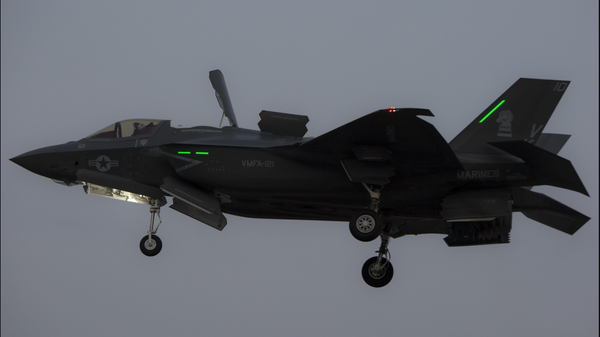US Air Force (USAF)’s Spencer G. Weide and Justin J. Newman became the first pilots to fly the F-35B Lightning II aboard an amphibious assault ship, according to a Marine Corps news release. The F-35B is the stealth warplane’s special version designed for vertical or short takeoffs and landings.
The pilots “made history” as part of integrated drills aboard the USS America in the Eastern Pacific which were held earlier this week.
Look What the Tide Rolled In
— U.S. Marines (@USMC) October 31, 2019
Marines and @USNavy Sailors observe an F-35B Lightning II with Marine Fighter Attack Squadron 122, Marine Aircraft Group 13, @3rdmaw, getting tied down prior to being transported to the flight deck aboard the amphibious assault ship USS America. pic.twitter.com/WxTR7zQHqJ
“This is a unique opportunity for the Air Force to integrate with Marines and sailors overseas,” Weide said, noting that integration was “the whole purpose of this training.”
“With the Marines, Navy and Air Force, we are able to build that integrated team,” he added.
He was echoed by Newman who underscored the importance of integrated training which he said would help the pilots “learn the naval and Marine warfare functions” and would also allow them “to return the knowledge back to the Air Force for better future integration.”
🇺🇸⚓United States Marine Corps 🇺🇸
— Elke Hansen (@ElkeHansen7) October 26, 2019
Lockheed Martin F-35B Lightning II, Departing USS America (LHA-6) Strike Group
USS America (LHA-6), amphibious assault ship United States Navy 2014, helicopters V-22 Osprey tilt-rotor
F-35B Lightning II aircraft and helicopter gunships. 🇺🇸 pic.twitter.com/RD4MhKNtgV
The remarks come a few months after the website Defence News cited developers of the F-35 programme as admitting that the F-35Bs can only fly at supersonic speeds for a short period of time because “there is a risk of structural damage and loss of stealth capability.”
“The F-35 Joint Program Office has classified the issues for the "B" and "C" models as separate category 1 deficiencies, indicating in one document that the problem presents a challenge to accomplishing one of the key missions of the fighter jet,” according to Defence News.
F-35 Reportedly Struggles With Spate of Issues
Earlier, the news outlet obtained documents which reveal that the F-35 Lightning II Joint Strike Fighter is troubled with more than a dozen issues that could either put the lives of pilots at risk or jeopardise a mission outright.
According to the documents, some F-35 pilots experience cabin pressure spikes which give them ear and sinus pain, while the jets can suffer structural damage at speeds beyond Mach 1.2 and have problems operating in areas with cold weather.
With an estimated price tag of between $150 and $200 million per aircraft and a lifetime programme cost of $1.5 trillion, the F-35 is already nicknamed by industry insiders as a “money-pit” given its continual patchwork corrections, repairs and upgrades.



